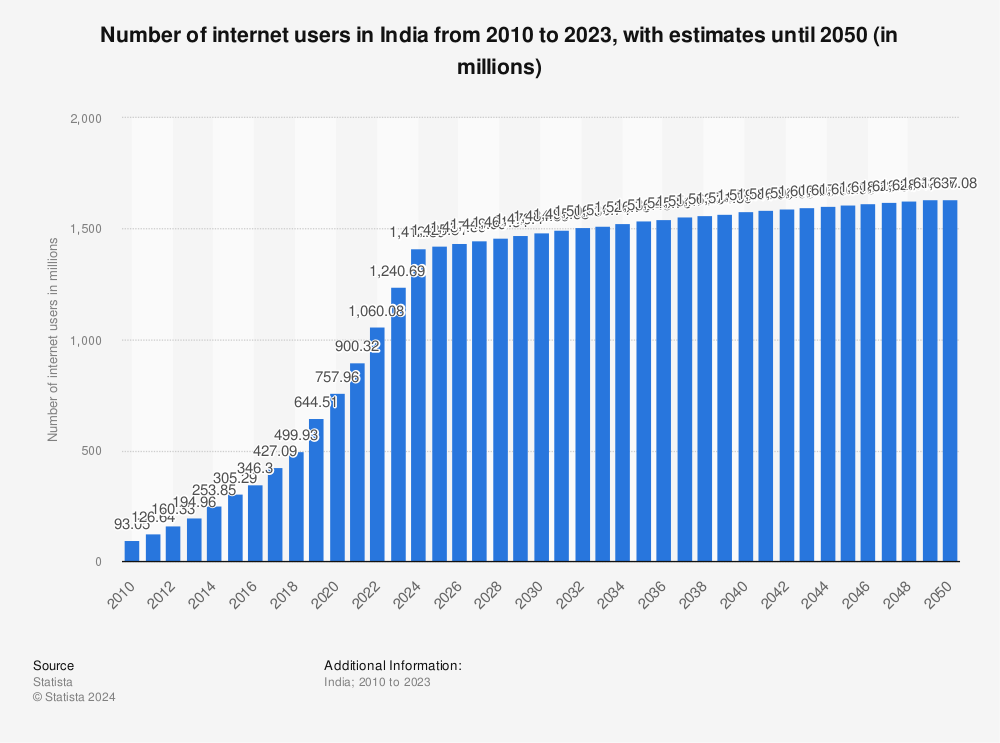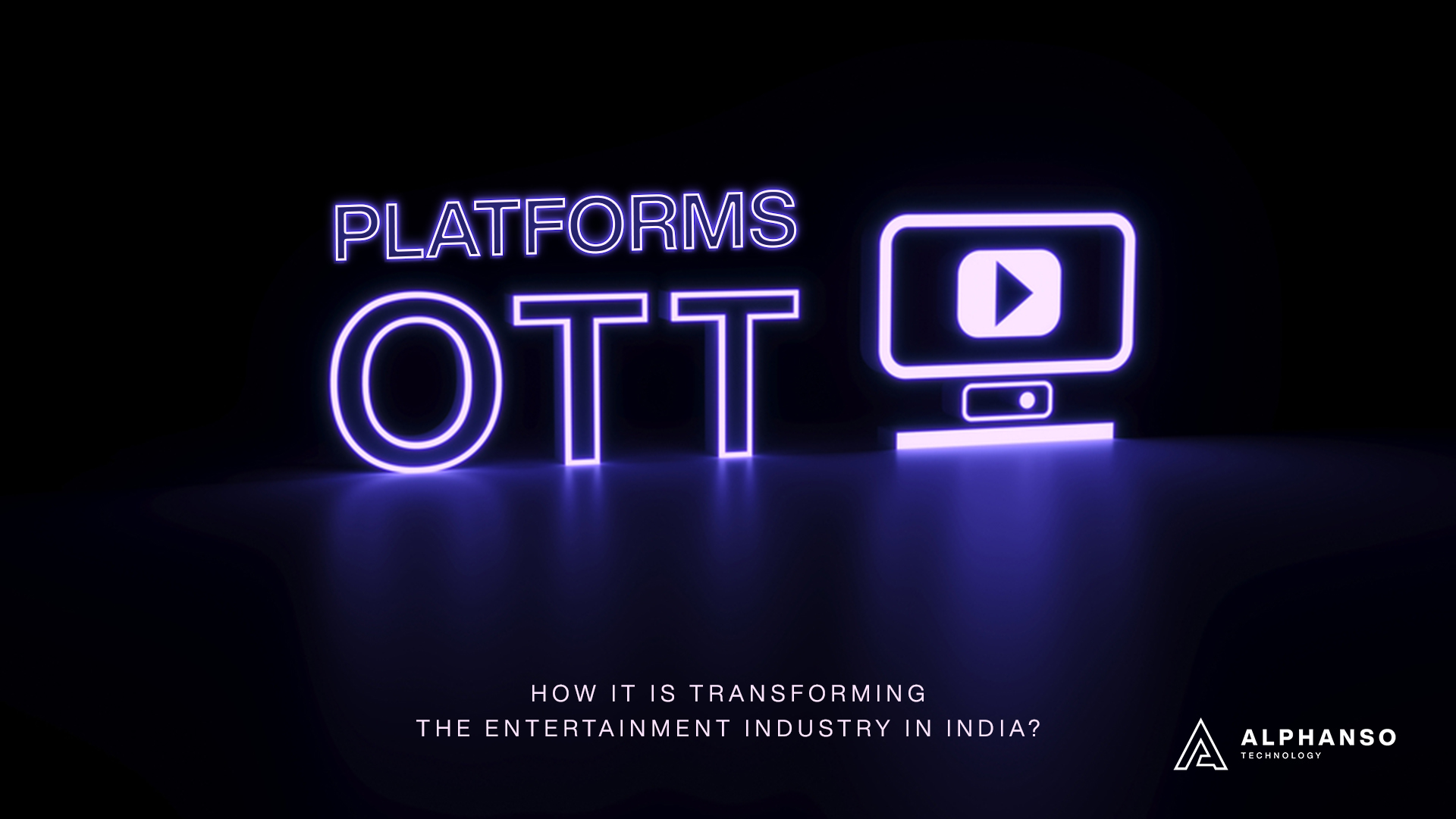No matter what you like to watch, there is a platform that satisfies all your entertainment needs. With technological advancement, the OTT platforms in the Indian entertainment industry are expected to grow even further, driving innovation in content creation and distribution.
OTT Platforms is Transforming the Entertainment Industry: Explore How?
Over-the-top platforms have revolutionized the entertainment scene globally. The online entertainment market is gaining traction in India. India had more than 1.2 million internet users in 2023; this figure is projected to increase and reach around 1.6 billion users by 2050, showing immense market potential in internet services.

Source: (Statista)
The increasing use of the internet and smart devices has resulted in an increase of OTT platforms among Millennials and Gen Z. The digital generation prefers to spend their lives on a computer, social media, and smart devices, leading to a dramatic change in customer behavior.
The mobile revolution coupled with low data prices has changed entertainment for modern generations. Do you want to know how OTT platforms are transforming the entertainment industry in India? Just read the article to find the answer right away.
Rise and Evolution of OTT Platforms Made Quality Content Accessible in India
The television industry was playing a monotonous tone, whereas the West shifted to “what to watch on Netflix.” The Urban generation, which fed Western media on the internet, started buying subscription plans when Netflix launched in India. India adapted to the new concept with open hands after the COVID-19 pandemic and global lockdowns.
The over-the-top market was valued at 101.42 billion in 2020; however, the market revenue is estimated to reach around $205,565 million in 2022, with India contributing $2,673 million. The OTT market is predicted to reach approximately 223.07 Billion by 2026, registering 13.87% growth during the forecasted period. The onset of the pandemic has positively influenced the OTT market as more audiences are enjoying content at home through OTT platforms.
With a 10.10% CAGR, the market is forecasted to reach around $3,928 million by 2026. This makes India the second critical market after China. The market revenue is expected to reach $63,106 million by 2026. The popularity of OTT in India owes its success to the increasing adoption and expansion of internet infrastructure that helps streaming platforms deliver content directly to viewers, bypassing media networks and traditional distribution.
Wide variety provides viewers the option to choose the content in the way they want, and at the time they want to consume it. Let’s explore more to know how OTT is changing the entertainment and media industry dynamics.
Build Direct Connection with Viewers
Broadcasters rely heavily on traditional distribution methods such as DTH platforms and cable. The launch of OTT media streaming has made it convenient for a broadcaster to showcase their content to viewers. This helps build strong relationships with the audience improve brand recall and develop a brand image.
Broadcasters can have detailed insight into big data and analytics, helping them know how viewers are interacting with the streaming content. The data-driven approach helps in chunking out improved content that is tailored to customers’ preferences.
Pushing Boundaries
Mobile is the most widely used streaming device in India. India serves as a battleground for established entities. For example, Netflix has a ₹149 per monthly plan for mobile-only. India’s dynamic market makes it the biggest playground for businesses and a solid statistical data set developer that contains a wide range of viewers for data harnessing.
Improved Content Viewing Experience Across a Variety of Devices
The most prominent reason for expanding the OTT industry is how they provide their services and improve customer experience. An effective way of achieving this is to provide a seamless content viewing experience across different devices. Therefore, OTT platforms must offer a seamless viewing experience across different platforms and devices. This can help them gain an ever-growing customer base.
OTT is the Best Option for Marketers and Advertisers
With OTT ad spending reaching around $1.3B, OTT has become a top priority for advertisers to shift budgets to streaming content and the entertainment industry. As the popularity of the OTT platform increases continuously, advertisers wish to explore these ad revenue channels to obtain quality traffic, showcase their products, and sustain audience growth. This helps to grow their marketing ROIs, leading to higher conversion rates based on user preferences and behaviors.
More Cord Cutting
With the popularity of OTT video streaming, the competitive dynamics of Pay TV vs OTT has evolved dramatically. The losers due to the tectonic shifts in content consumption are cable TV operators and traditional broadcasters. The US is the country with the highest number of pay-TV subscribers, and cord-cutting and other forms of viewer untethering have a visible impact on the TV media landscape.
The pay-TV penetration rate in the United States has decreased from 74 to 88% since 2010; more than 58 million households in the US will cut the pay-TV cord by 2024. The number of pay-TV households in the US will stand around 68.5 million by 2022. Cable TV operators are losing subscribers due to a lack of comparable choices and high prices, leading to “cord-cutting” that changed the broadcasting market.
Image: (Source)
India has around 69 million active DTH (direct-to-home) television subscribers as of September 2021. The number decreased compared to 2020. Some of the key DTH operators in the country are Dish TV, Airtel, and Tata Sky (Play Now). Because of its mandatory regulation, India has a 100% digital cable television network.
The growth of OTT platforms with the pandemic’s spread seems to affect the monopoly of cable television in the country. This decline is amplified because of the increasing cost of cable subscriptions compared to streaming platforms.
Opened Opportunities for Creators
There isn’t a lack of creative creators around the globe. OTT platforms are proven as the pallbearers of broadcasters and production houses that believe in creating and showcasing exclusive content. Creators and artists who have lost relevance in the past have found their place in the limelight again. For example, series like “Aarya” starring Sushmita Sen, “Aranyak” featuring Raveena Tandon Thadani, and more have recently.
Visual content helps creators launch their content globally with OTT, especially when the content of the East found a taker and accomplished business in the West without any hurdles like language, etc. All this gave a much-needed boost to the industry. OTT achieved that with a change in audio which closed caption facilities for immediate consumption in non-local regions.
It boosted revenue generation for production houses and independent creators by opening opportunities for using licensed content by partnering with social platforms. For example, big houses like Eros Entertainment and SaReGaMa are licensing music to social channels like YouTube and Instagram to use for shorts and reels.
DTH TV Operators Collaborating with OTT
An increasing number of cord-cutters have decreased revenue for DTH TV operators, who are searching for new ways to get their viewers back. Due to the growing popularity of video streaming among Gen Z and millennials, film giants and traditional TV are seeking to partner with Amazon, Netflix, and Disney+ Hotstar.
Most companies such as Airtel and Reliance Jio are trying to attract viewers with bundled offerings of OTT platforms along with STB units. For example, Tata Sky has partnered with Amazon Firestick to launch devices for streaming that enable viewers to view different content from diverse OTT platforms via a single subscription plan.
With OTT platforms transforming viewers’ viewing habits, strategic partnerships of DTH operators with OTT will drive the growth of the Indian entertainment industry with such combo models.
Power of Modern Technology
Emerging OTT video technologies are using modern technology like AI to improve customer experience. The use of artificial intelligence helps to determine what the audience loves to watch and helps OTT service providers earn revenue and deliver a personalized experience. For example, Netflix has saved $1 billion a year with the use of artificial intelligence.
However, the advent of 5G technology will ensure improvement in customers’ experience like never before. High speed and ubiquitous connectivity help to eliminate buffering, unwanted pixelation, and lag annoyingly. The combination of 5G technology and OTT will give a massive boost to VOD and live streaming.
Parting Words
India’s diversity leaves enough room for existing OTT players as well as for those who are planning to launch new in space beyond entertainment. It’s the beginning for OTT platforms and the slow death for traditional delivery platforms and content creators.
Undoubtedly there are many issues in terms of paying capacity, market penetration, censorship, platform multiplicity, and ever-changing consumer behavior. Change in broadcasting preferences is glaring, and the availability of choice continues to bring change in the way that content is distributed and created for the audience.
The content creators and production houses have realized the importance of entering into a war between OTT and Pay TV. The OTT video streaming industry provides opportunities for cable operators and broadcasters to grow. With viewership escalating on the OTT side, broadcasters can’t miss the opportunity of directly showcase their offering directly to the audience.
Frequently Asked Questions (FAQs)
What are OTT platforms?
OTT platforms are streaming services that deliver content directly to viewers over the internet, bypassing traditional cable or satellite television. Examples include an app like Netflix, Amazon Prime Video, Disney+ Hotstar, and Zee5.
What is the impact of OTT platforms on traditional TV viewership in India?
OTT platforms have led to a decline in traditional TV viewership, especially among younger audiences who prefer the flexibility and variety offered by digital streaming services.
How are OTT platforms leveraging technology to enhance user experience?
OTT platforms use advanced algorithms for personalized content recommendations, support high-definition and 4K streaming, and offer features like offline downloads and interactive content to improve user experience.
What are the benefits of OTT platforms for content creators?
OTT platforms provide a global stage for content creators, enabling them to reach wider audiences without traditional barriers. They offer opportunities for independent creators and established production houses to showcase original and diverse content.
How are OTT platforms impacting the advertising industry?
With OTT ad spending reaching significant levels, advertisers are shifting budgets to streaming platforms to leverage targeted advertising and achieve higher engagement and conversion rates based on user preferences.
What is the future outlook for the OTT market in India?
The OTT market in India is expected to continue growing, driven by increasing internet usage, technological advancements, and evolving consumer preferences. The market revenue is forecasted to reach $3,928 million by 2026 with a 10.10% CAGR.
What opportunities do OTT platforms offer for traditional broadcasters?
Traditional broadcasters can expand their reach by collaborating with OTT platforms, leveraging digital distribution to showcase their content directly to viewers, and tapping into new revenue streams.

